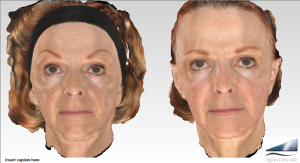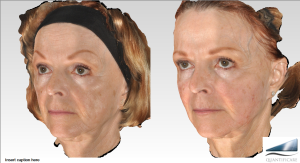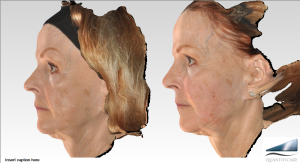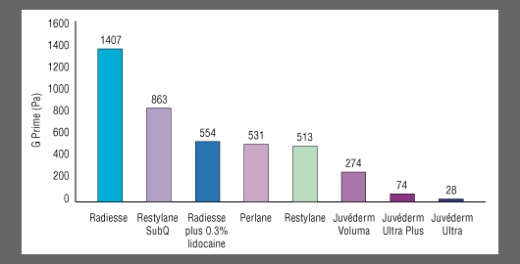



[youtube=http://www.youtube.com/watch?v=XERvczwIOOg]
[youtube=http://www.youtube.com/watch?v=wd9r3Tw43YU]
Juvederm Voluma was approved by the FDA today for treatment of age related volume loss in the cheek area. This is the first filler to be approved for this purpose. Its main component is Hyaluronic acid which is also found in Juvederm Ultra, Restylane, Perlane, and Belotero, all FDA approved fillers. Juvederm Voluma is a thicker, more viscous version of Juvederm Ultra which gives it more “substance”. The technical term for this property is called “G prime”. The higher the G prime, the better ability for the filler to lift and support skin and surround structures. Compared with Juvederm Ultra, Juvederm Voluma has about 10 times (10X) the G prime. A comparison graph is shown below (from Going With the Flow: An Overview of Soft Tissue Filler Rheology and Its Potential Clinical Applications, Part II by Hema Sundaram, MD, FAAD):
As seen in the chart, Radiesse, Perlane, and Restylane have higher G primes than Juvederm Voluma. Although these others are not approved for volume loss of the cheek, they are all used commonly “off label” for this application.
Being very thick/viscous, Voluma will need to be injected with large bore needles or blunt cannulas. It is mixed with lidocaine (numbing medication) from the factory, so the procedure is very well tolerated. It’s longevity is longer than most fillers, lasting up to 2 years in their clinical trials. At 2 years, 76% of patients were still satisfied with their Voluma results. (It was 90% at 6 months). Also, at 2 years, the average patient’s perception was that they looked 3 years younger since the Voluma treatment. (It was perceived as 5 years after 6 months).
Obviously, the volume needed for correction varies from patient to patient, depending on their degree of volume loss. During the clinical trials, the average volume needed for correction was just over 6cc. Some patients needed up to 13 syringes.
An advantage of Voluma over Radiesse, Artefill, or Sculptra is that Voluma can be “erased” or dissolved with an easily obtained enzyme called hyaluronidase. Although it is seldom used, it can give patients the piece of mind that their results don’t have to last for a year if they aren’t happy with it.
Initially, Voluma is being released to a select number of physicians who are very experienced injectors. These physicians will then become trainers for the other physicians with less experience. Dr. Weiner has been chosen as one of these initial users of Voluma, and it should be available at his office in November.
Dr. Weiner is Facial Plastic Surgeon who laid down his scalpel in 2005 and now concentrates on minimally and noninvasive cosmetic procedures. His website is http://www.theclinique.net His YouTube is: http://www.youtube.com/user/StevenFWeinerFacial
we’d love to meet you
Schedule a consultation
Are you ready to take the first step towards achieving your goals? Book Now or Contact Us first with any questions today!
Have a Question?





